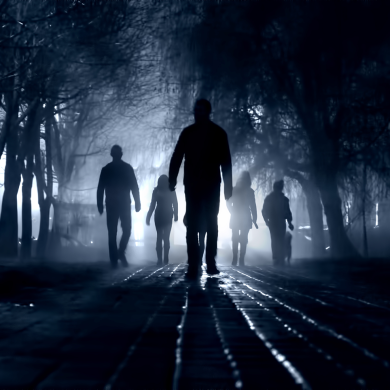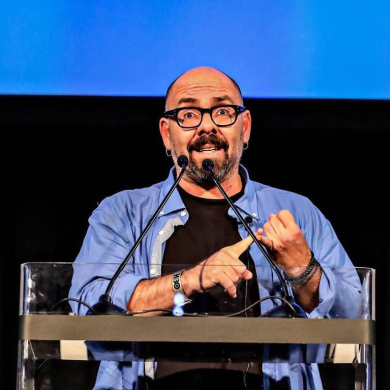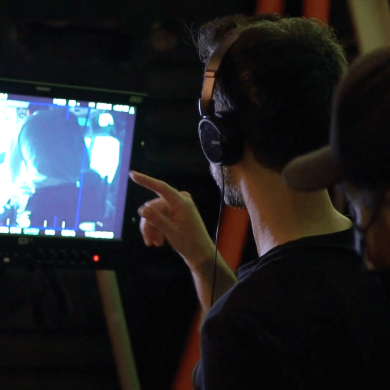By: CreativeFuture
Hollywood is rife with cinematographers, but it’s a safe bet that only one of them has had the distinction of crafting on-screen imagery for both Seth Rogen and Rob Zombie. His name is Brandon Trost, and, at the age of 36, his resume already includes director of photography (DP) roles on more than a dozen studio films, including This Is the End, Zombie’s Halloween II, and The Lords of Salem.
“I just like making movies,” Trost told CreativeFuture. “Anything and everything.”
This simple but effective approach has seen Trost put his visual stamp on just about every genre of film imaginable, from high-octane action romps such as Crank: High Voltage, to coming-of-age indie dramas like The Diary of a Teenage Girl – which took home the 2015 Dramatic Special Jury Award for Best Cinematography at the Sundance Film Festival. He attributes his prolific versatility to an uncanny ability for letting the director’s vision guide the visuals for the given project, and not vice-versa.
“I feel like if you’re looking at something that I’ve shot, and you’re thinking, ‘Wow, that’s a cool shot,’ and you’re not paying attention to anything that’s happening within the story, then I’m doing a disservice to what’s being told,” Trost said. “My style translates to whatever the movie calls for.”

Which is all to say that, clearly, filmmaking is in Trost’s blood, starting with his father, the special effects wizard Ron Trost (Mortal Kombat, Rushmore), and extending out to his great uncle, the beloved character actor Victor French, who starred with Michael Landon on hits such as Little House on the Prairie and Highway to Heaven. Years later, Trost would bring the familial connections full-circle when he served as DP on Scouts Guide to the Zombie Apocalypse, directed by yet another talented filmmaking progeny, Michael Landon’s son, Christopher.
CreativeFuture: Your resume is so vast, it’s hard to know where to begin, but let’s go with your first studio film, Crank: High Voltage. Technically speaking, that seems like a crazy movie to start out with.
Brandon Trost: Crank: High Voltage was a bonkers movie to have as a first studio film. This was 2008 and we wanted to shoot it on high-definition digital video, which at the time was unheard of. Now you can just shoot a movie on digital, but back then it was a big leap for a studio to make. The studio was like, “Wait, you’re going to shoot with consumer cameras on a $20 million budget? We’re not doing that. That’s insane.” We had to test it and show them our idea, and ultimately it went through.
Essentially, we shot the whole movie like a skate video. I’d have three or four different cameras being operated at once, and then I’d plant small cameras in different spots that I called “Easter eggs” ¬– they were hidden all over. If there was action happening, then we were in it. There was this explosive creative energy in the way it was made. You feel it in the movie.
CF: One fascinating element of your career is how you took those skills you honed shooting genre fare like Crank: High Voltage, and then Rob Zombie’s Halloween II after that, and proceeded to apply them to all these incredibly successful comedies.
BT: The whole comedy thing really started with MacGruber. I think director Jorma Taccone actually hired me because I wasn’t a comedy DP then. I had action stuff and horror stuff and some dramatic work. It made sense because we wanted the joke of MacGruber to be that it was an ‘80s action movie. It existed in that world, without any wink to the camera. It was matter of fact. That was the style. Then all these comedy people saw MacGruber and started calling me in for meetings, and that’s how I met Seth Rogen and Evan Goldberg.
CF: You have since enjoyed a long and fruitful partnership with Rogen and Goldberg, shooting movies they directed such as This Is the End and The Interview, or that they produced, such as both Neighbors films. Having honed your studio chops as an action and horror cinematographer, how was it adapting to their filmmaking style?
BT: I have had to lean into the idea that there might be mistakes. I don’t like things to be perfect on their projects. If something is overly glossy or too refined it almost pushes me further away from what I’m watching. I’d rather be a little rough around the edges. They love improvising – so, particularly with a film like This Is the End where you’ve got six pros in a room together all improvising, you’ve got to shoot it with multiple cameras to make sure you catch everything.
For all the scenes when everyone is in the same room together we had to bring in a third camera. We had three cameras rolling the whole time pointing in every direction. I’d say that trend started with comedies predominantly in the 90s. Now it’s become a comedy formula to have multiple cameras going, even when it’s scripted.
CF: You have the unusual distinction of collaborating with both Seth Rogen and Rob Zombie. How did you wind up working with Zombie?
BT: Halloween 2 was the next studio movie I did after Crank 2 and Rob and I hit it off from the start. I went into the first meeting with him wearing my Turbojugend jacket. [Editor’s note – This is the official garb of the fan club for Norwegian heavy metal band, Turbonegro. At the time of his meeting with Zombie, Trost was president of the club’s Frazier Park, California chapter.] I thought he might appreciate it, and he mentioned it immediately.
CF: Did your passion for heavy metal help you bond with Zombie?
BT: I think so, and not in a fake way. We had a lot in common – culturally and creatively. I felt like when we started working together, there was this creative partnership that developed. He usually has a very specific idea about what he wants to do, but he leaves himself open for spontaneity and allows for what happens in the moment. It’s very collaborative. There’s no bravado – it’s always about what is best for the scene.
CF: What was your upbringing like?
BT: I was born in the valley [and grew up] in the Frazier Park area – a mountain community north of L.A. It’s in the middle of nowhere. I grew up loving action, science-fiction, and fantasy movies, and listening to bands like Danzig, Black Sabbath, and Nine Inch Nails. I wasn’t super into sports. I had friends, but I was more of a lone wolf. I spent a lot of time with my siblings up in the mountains, doing things like watching movies and playing video games.
CF: You come from a long line of show business professionals. Talk about your family and its legacy in entertainment.
BT: I’m a fourth-generation filmmaker and Los Angeles native. It’s on both sides of my family, actually. It goes furthest back on my mom’s side. My great grandpa was a stunt guy. He was kind of a cattle dude who could ride a horse and that translated into being a stunt guy for films. His son, my grandpa’s brother and my great uncle, was Victor French, the actor from Little House on the Prairie and Highway to Heaven – all those Michael Landon shows. Funny enough, I ended up shooting a movie for one of Michael Landon’s sons, Chris, years later: Scouts Guide to the Zombie Apocalypse.
On my Dad’s side, my grandfather was an assistant director and production manager, and he worked on movies like King of Comedy with Martin Scorsese, and Thief with Michael Mann, and Unforgiven. My grandma also used to be a stuntwoman. She doubled Angie Dickenson for years. Then my Dad did special effects. He did the Mortal Kombat movies, which I thought was awesome when I was a kid, and he worked on great indie movies like Rushmore.
I was actually on the crew for Rushmore when I was 16, and I played the Vietnamese soldier that runs up with the rocket launcher (laughs). My brother and sister were on it, too. My sister is a costume designer and my brother is an indie filmmaker. We’re all in the mix. I’ve never had a job that wasn’t in the film industry. I didn’t go to college. I just went to Los Angeles Film School and then hit the ground running.
CF: Los Angeles Film School is a trade program – how do you think getting your training there compares to, say, learning the ropes at a traditional four-year university or post-graduate film school?
BT: I was prepping myself for the full four-year experience. I assumed I would start at a junior college and end up at UCLA or USC or something. Then I stumbled upon Los Angeles Film School, which was brand-new then. Now they’re accredited and all that, but back then it was a certificate-based program, a ten-month intensive – you’re in, you’re out. It was learning by doing and it seemed to suit my style. I just wanted to hit the ground running and I didn’t want to waste time.
I think the thing that was most important about L.A. Film School was the relationships – the network I built there is what birthed my career, ultimately. I wouldn’t have gone anywhere without the people I knew who were also on the same path. Most of what I learned in terms of how to do my job, I learned after film school. But film school taught me all the basic fundamentals.
CF: After finishing school, how did you then start carving out your career in Hollywood?
BT: Traditionally, to become a director of photography, you start out as a loader, then become a second assistant cameraman, then a first assistant cameraman, then an operator – you work your way up the chain. But I didn’t do that. I thought that I could just practice shooting and get good at shooting rather than practicing another job to work my way up.
CF: So, starting out, your professional approach was to work as a DP or bust?
BT: I realize now that it’s a pretty scary thing to do, but I was pig-headed enough when I was younger to just go for it. I never imagined another reality. I always assumed it would work out. I shot a lot. There was a time when I would never say no to a project – I’d say yes to everything. I figured anything I did would either give me more experience or provide a little money to keep rolling along. I worked really hard the first ten years out of film school, on both good and bad stuff. I think getting my start was a combination of preparation meeting opportunity. Sure, I got a studio film when I was really young and I lucked out on that. But I was also ready for it.
CF: Let’s talk about the day-to-day grind of being a cinematographer. How does each new project begin?
BT: I usually get a phone call from a friend I’ve worked with before and they ask if I want to do their project, or my agents set me up with a meeting for something I’m interested in. If I get the gig then agents figure out a deal, and I show up for the prep period. Then I talk to the director about the style and that sort of thing. We have a pre-production office wherever we’re shooting, and then we do tests. We get a team together. Sometimes I’m hiring new people if we’re working in a new city. I work with the production designer in terms of set layout and whether we have enough room to do the shots we want.
CF: What does honing in on the director’s visual style entail?
BT: It’s different with everyone, but it usually starts with either a description of what the director wants it to feel like, or we sit down and watch movies to make that decision. We’ll watch a bunch of films to figure out what the style is. I shot a pilot for a television show that comes out this year called Barry that Bill Hader directed and wrote with Alec Berg.
It’s this awesome HBO series about a hitman who comes to L.A. to take out a target and the guy he goes to kill is in a fringe theater company. And then he realizes, “Wow, I want to do this. This is for me.” It has a Coen Brothers tone to it – a lot of dark humor. When Bill [Hader] and I sat down to talk, he had a very specific idea of how he wanted the pilot to look. He listed different scenes from different films and he painted a very clear picture of the visual style.
I feel like that approach is similar for most directors I work with. We talk about ideas and create a set of rules that we agree upon and that’s what we stick to. I have to know what the rules are and then decide whether to break them. It keeps me focused on the target so I know that I can answer questions based on that rule set and I know that every decision we make points us in that direction, so the movie will match when it’s time to cut it together.
CF: Have you ever had one of these early meetings with a director and then walked out just blown away by their vision?
BT: I felt that way with The Lords of Salem, actually. That was my second Rob Zombie film. It was much smaller than the first one, and much different. I was shooting an Adam Sandler movie, That’s My Boy, in Boston, and Rob [Zombie] was living in Connecticut. We knew the movie was coming up after my Sandler shoot, so I drove down to hang out with him and talk about the film. We watched movies that I hadn’t seen before, like Ken Russell’s The Devils, which is stylized in this brilliant way.
We also watched Roman Polanski’s The Tenant, specifically looking at how they played with the interiors and the apartment building, and we watched Suspiria. Once I realized we were working with inspiration from those three films, I thought, “Wow, this is going to be amazing. I’ve never done anything like this before.” This slow burn, early ‘70s, European horror film style, which couldn’t be further from Rob Zombie’s other film, Halloween II.
CF: Do you think you bring a distinct style of your own to the table?
BT: I hope not. The story should come from what the director wants and what the movie calls for – it shouldn’t be about putting my style or my signature on it. I’d prefer that you look at something I did and think that maybe another DP could’ve done any of it. Look at Crank: High Voltage, Halloween II, and MacGruber. Those are three movies I did in a row and each one is so unlike the other that I think a different person could’ve shot it. I’m proud of that.
CF: What advice would you give someone who wants to become a DP?
BT: If it’s something you want to do and you love it, just keep doing it. You really have to put the work and the time in. Practice, keep working, and don’t be an a**hole. Actually – I think those three things could help anyone, no matter their field.




